Marine Science News 2023
Could seaweed help save the planet? Blue carbon solution to be investigated by AIMS
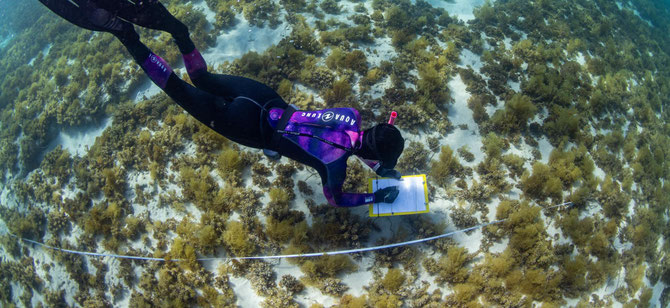
The Australian Institute of Marine Science (AIMS) is exploring how a seaweed called Sargassum could reduce the severity of climate change by storing carbon in tropical seascapes. The five-year, $20 million Blue Carbon Seascapes research project is jointly funded by AIMS and BHP to measure how much blue carbon is flowing from Sargassum into different coastal and deep ocean environments, how long it is stored there, and how we can best protect and enhance this natural process.
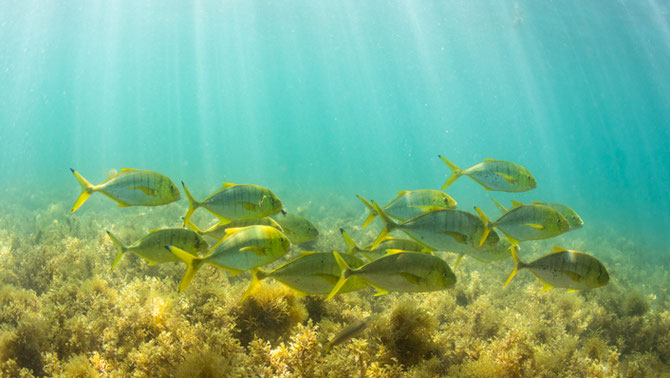
Blue carbon refers to the carbon stored in our oceans via the natural pathway of photosynthesis. Plants like mangroves, seagrass and seaweeds use photosynthesis to absorb carbon dioxide from the air and water around them and use this to help grow their leaves, stems and roots. When pieces of these plants break off and become buried in the mud the carbon they contain is safely locked away from the atmosphere for hundreds to thousands of years. AIMS acting CEO Basil Ahyick said Blue Carbon Seascapes is a major new program of public good research for AIMS, Australia’s tropical marine research agency. “AIMS has a clear strategy to protect Australia’s marine ecosystems from the effects of climate change,” said Mr Ahyick.
“Our initial research has found there are natural processes under the waves that could help. It’s imperative we explore these options to support healthy tropical oceans into the future. We welcome BHP’s involvement in this project as a funding partner as we accelerate our progress towards our vision of supporting resilient, healthy oceans.”
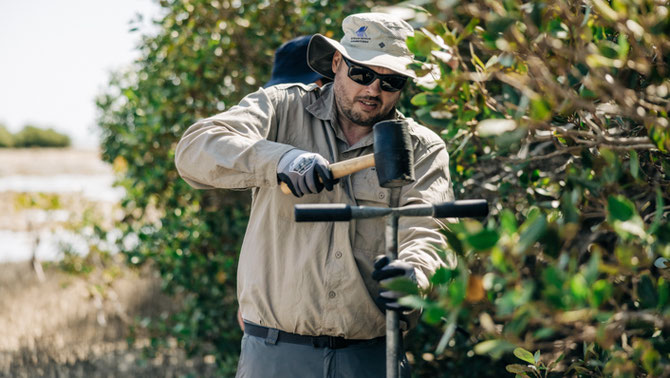
Principal Research Scientist Dr Chris Fulton said the research would help to answer fundamental questions in blue carbon science. “We know that vast meadows of Sargassum naturally grow along tropical coasts around the world, including Australia, where every summer they go through a rapid growth spurt, soaking up carbon from the seawater around them as they grow. Once Sargassum has completed its breeding cycle in autumn, the seaweed naturally breaks away from the bottom and flows across the seascape, taking most of the accumulated carbon with it,” he said. “Some of this Sargassum provides food for the many species that occupy our tropical oceans, but there are tantalising signs that Sargassum-bound carbon is also buried in the mud under mangroves, seagrass beds and in the deep sea. In this Blue Carbon Seascapes project, we are collecting the hard data needed to verify how much Sargassum carbon is being stored in our tropical oceans.”
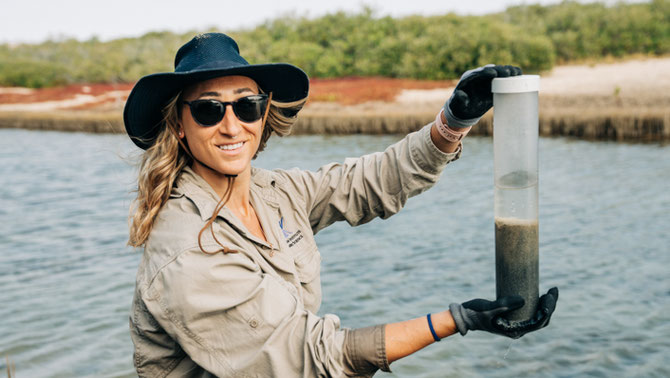
Investigations for the Blue Carbon Seascapes project are already underway off the Western Australian coast. AIMS scientists have been collecting soil cores from mangroves along the Ningaloo and Exmouth Gulf coasts to measure how much blue carbon is stored within these soils, how long that carbon has been buried, and which plant fixed that carbon before it was buried. More soil cores will be collected around Port Hedland in early 2024. All outcomes of the research will be fully scrutinised via independent peer review and made freely available to the world, helping to advance national and international blue carbon policies, standards and methods. It will also provide transparency, accountability and confidence to industry, businesses and governments to adopt blue carbon solutions in achieving their emissions reduction targets. Dr Fulton said the findings will be transferable to many parts of the globe and will help fill knowledge gaps in this developing area of science.
“If we find that Sargassum can be a solution to safely store carbon in our oceans, this project will provide a game-changing addition to our portfolio of solutions to climate change,” he said.
“Reducing our future greenhouse gas emissions must be coupled with solutions to draw down the excess carbon already in our atmosphere - blue carbon is one solution to achieve this drawdown using the ancient process of photosynthesis in the sea.”
October 19 2023
Source: Australian Institute of Marine Science' CC BY
The secret lives of silky sharks: unveiling their whereabouts supports their protection
Open ocean sharks are elusive and mysterious. They undertake vast journeys that span hundreds to thousands of kilometres across immense ocean basins. We know very little about the secret lives of ocean sharks, where they live and why they are there.
What we do know is sharks are immensely important to the natural systems in which they live. Over 450 million years of evolution have perfected their role as apex predators and they play vital roles in fish community regulation and nutrient cycling. Healthy ecosystems rely on healthy shark populations.
Sharks, numbering more than 500 species, are also among the most threatened groups of vertebrates (animals with backbones). After surviving five mass extinctions through geological time, sharks are now facing the greatest threat to their survival from industrial fishing.
Their elusive nature and the immensity of our oceans means sharks are difficult to study. Our limited knowledge is particularly problematic given their threatened status. A solid understanding of the distribution of oceanic sharks is fundamental to their protection and our new research provides valuable insights into the secret lives of these wide-ranging predators.
Silky by name, silky by nature
Silky sharks (Carcharhinus falciformis), named for the silky-smooth feel of their skin, are emblematic of open ocean sharks. They are highly mobile, have long life-spans, and are slow to reproduce. They are found throughout tropical and sub-tropical waters.
Silky shark numbers have declined globally due to industrial-scale fishing. Targeted for their fins and meat, they are also frequently incidentally caught in tuna fisheries. In 2017 the International Union for the Conservation of Nature classified this species as vulnerable to extinction. Their trade is controlled under the Convention on International Trade in Endangered Species.
What we did
Baited remote underwater video systems, or BRUVS for short, are used to document the wildlife of the open oceans. Armed with a pair of small action cameras and baited to attract predators, BRUVS are suspended at 10m depth and drift with ocean currents. Video analysts review the footage to identify, count and measure all observed animals.
BRUVS have previously revealed the impact of human activity on marine predator populations, the ecological value of offshore oil and gas platforms as novel ecosystems, and even that tunas use sharks to scratch their itches.
We deployed more than 1,000 BRUVS across the Atlantic, Pacific and Indian oceans between 2012-20 to record where silky sharks hang out and predict how many there are and how big they are.
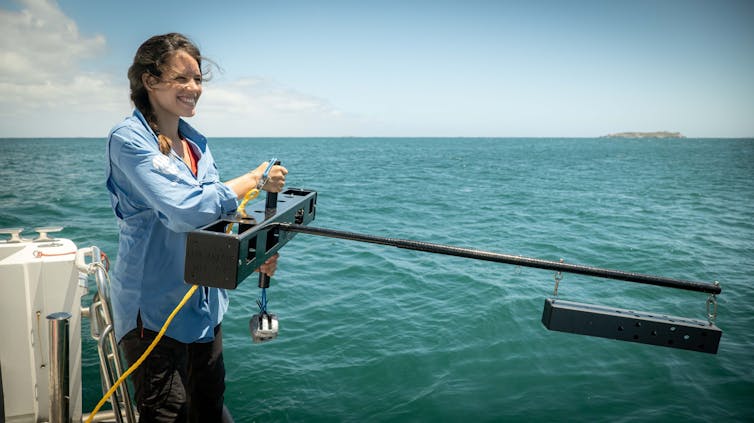
A love affair between silky sharks and seamounts
Silky sharks love seamounts. The closer we sampled to seamounts, the more frequently we observed silky sharks, and in higher numbers.
Seamounts are huge underwater mountains that rise from depths of thousands of metres to pinnacles that summit from hundreds to just tens of metres below the surface. The best estimate predicts the occurrence of more than 37,000 seamounts worldwide.
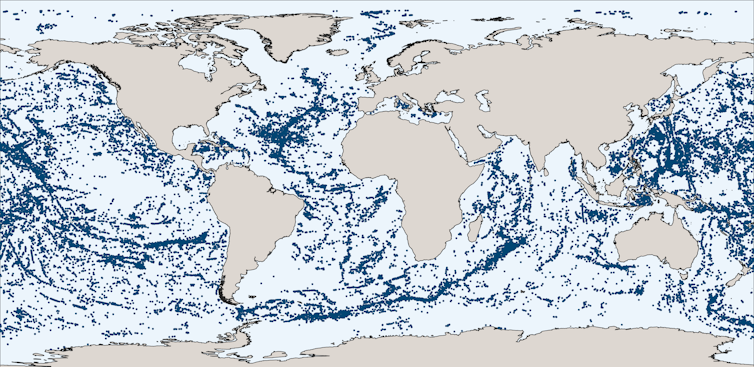
Seamounts are often hotspots of marine biodiversity. They act as landmarks in the otherwise relatively featureless open ocean seascape. Seamounts provide feeding, breeding, and resting spots for ocean roamers such as sharks, tuna, and whales. Migratory wildlife also use seamounts as navigational beacons and as stepping stones along their trans-ocean journeys.
Our results also reveal the smallest silky sharks hang out closest to seamounts. Seamounts may provide a rich smorgasbord for these rapidly growing youngsters.

A human footprint on silky sharks
Humans are leaving their heavy footprints on much of the ocean and silky sharks are no exception. Silky shark numbers declined the closer we sampled to coastal ports. Only the most remote areas had high numbers of silky sharks.
Silky sharks close to ports and human populations were also smaller than those observed further away. Such patterns are consistent with fishing impacts as exploitation typically first removes the largest individuals from the population. Our results reflect those for other open ocean sharks: hammerhead, sandbar, tiger and whale sharks have all declined globally in numbers and size .
The distribution of silky sharks exemplifies the pervasive and negative impacts of human activity on oceanic sharks more generally. It highlights the critical need for refuges in which these animals are protected from exploitation.
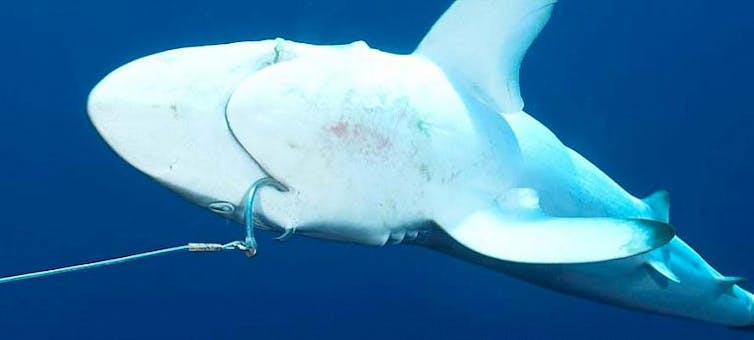
A path to protection
The need for improved protection for oceanic wildlife is well-recognised and marine protected areas are a key tool to deliver this protection. In 2022, under the Convention on Biological Diversity, nearly every country in the world committed to protect 30% of their oceans by 2030.
In 2023, the High Seas Treaty was ratified by the 193 member states of the United Nations, paving the path towards strong and effective protection of the vast swaths of ocean beyond national jurisdiction. Given that less than 2.9% of our oceans are currently highly protected, such opportunities are essential.
Our research provides clues on how best to harness these agreements to protect silky sharks and their open-ocean companions. If marine protected areas are going to work, they need to include areas that threatened wildlife inhabit. As seamounts are hotspots for silky sharks, they are a fitting focus for marine protected areas.
It has never been more important to protect sharks. We have never had as much knowledge to do so. We hope recent commitments to ocean protection will spur research to further unveil the secret
lives of oceanic sharks and ensure their survival in the face of their greatest threat yet.![]()
Shona Murray, PhD candidate, The University of Western Australia and Jessica Meeuwig, Wen Family Chair in Conservation, The University of Western Australia
31 July 2023
This article is republished from The Conversation under a Creative Commons license. Read the original article.
Is the Great Barrier Reef reviving – or dying? Here’s what’s happening beyond the headlines

The Great Barrier Reef is not dead. Nor is it in good health. The truth is complex. To understand what’s going on takes more than a headline.
For the last 37 years, our organisation has monitored the health of the world’s largest reef. Each year, we add our findings to our dataset, the Reef’s longest running and largest coverage. This lets us produce annual updates for the northern, central and southern regions of the Reef. That makes us perhaps the team best qualified to answer the question many people have – how is the Reef going?
Released today, this year’s update paints a complex picture. It wasn’t long ago the Great Barrier Reef was reeling from successive disturbances, ranging from marine heatwaves and coral bleaching to crown-of-thorns starfish outbreaks and cyclone damage, with widespread death of many corals especially during the heatwaves of 2016 and 2017.
Since then, the Reef has rebounded. Generally cooler La Niña conditions mean hard corals have recovered significant ground, regrowing from very low levels after a decade of cumulative disturbances to record high levels in 2022 across two-thirds of the reef.
The Reef has shown an impressive ability to recover from widespread disturbances, when it gets a chance – it’s not all just bleaching and death. But it’s also true we’re heading towards a future where hotter water temperatures will likely cause bleaching every year, along with ongoing threats of cyclones and coral-eating starfish. Recovery requires reprieve – and those opportunities will diminish as climate change progresses.
Last year, for instance, parts of the Reef experienced bleaching in the middle of La Niña – the first time that’s happened on record.

What’s happening on the Reef?
To take the pulse of the Great Barrier Reef, one indicator we use is hard coral cover. It’s a widely used, robust indicator of reef health, but it doesn’t tell the whole story. We also collect detailed data on coral and fish populations, diversity, structural complexity, and abundance of juvenile corals. And we take digital photographs and convert them into 3D photogrammetry models so we can analyse what’s happening in more depth than ever before.
Here’s what our analysis shows.
Over the last few years, the Reef was mostly in La Niña conditions. That gave the hard-hit northern and central parts of the reef a chance to begin recovery. Many reefs had a high proportion of Acropora corals, of which the best known are the staghorn and plate corals. These species have been a vital part of the reef over 37 years of monitoring – and probably for millennia.
These corals are the most common on many reefs, and grow fast. Because of that, they tend to dominate trends in hard coral cover.
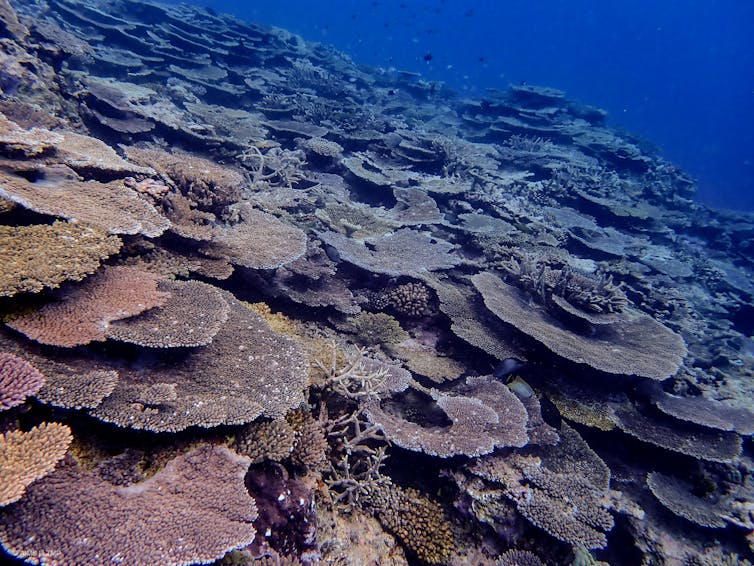
Does this mean the Great Barrier Reef’s recovery in 2022 relied on “weedy” corals which are taking over? Yes and no. The natural ecological niche of Acropora corals has always been to rapidly fill empty space, which means it tends to dominate trends in coral recovery.
Again, the story is more complicated than the headlines. Some reefs have recovered strongly, some very little. Some reefs are recovering with less Acropora than before, some with more. Each reef is charting its own course on the journey from impact to recovery and back again.
Overall, the record high hard coral cover seen last year was welcome news, representing recovery across much of the Reef in the absence of common coral killers.
But what about recent heating?
This year, the rapid coral rebound paused. Some reefs continued to recover, but these were offset by others which lost coral. Coral loss came from effects of the 2022 bleaching event in northern and central regions, crown-of-thorns starfish predation in the northern and southern regions, damage from Tropical Cyclone Tiffany in the north and coral disease in some areas of the south.
The picture is complex. Recovery here, fresh losses there.
While the recovery we reported last year was welcome news, there are challenges ahead. The spectre of global annual coral bleaching will soon become a reality.
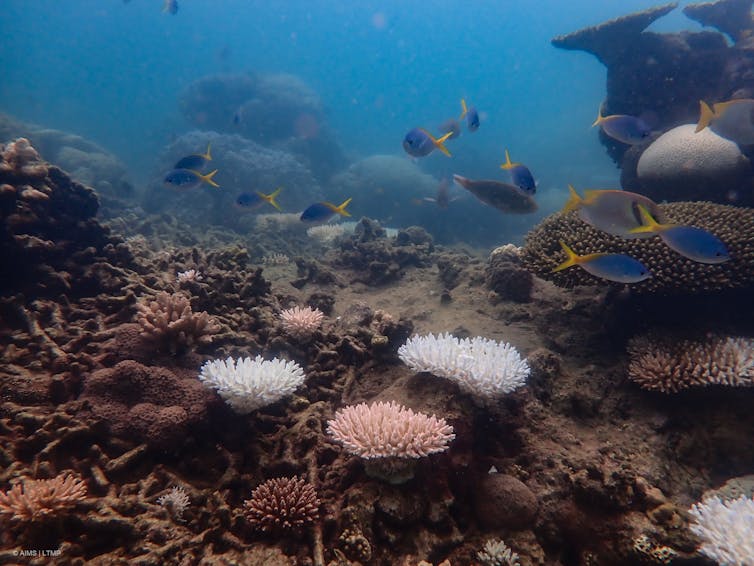
Right now, marine heatwaves are sweeping through ocean basins in the northern hemisphere. Sea surface temperatures are far above long term averages.
At least eight countries are reporting coral bleaching, including the United States and Belize. This summer, it looks likely we’ll see our first El Niño on the Great Barrier Reef since 2016, bringing higher sea surface temperatures. That last El Niño – coupled with global heating – was the direct cause of the 2016–17 mass bleaching and mass death of corals.
The prognosis is, in short, extremely concerning. Yes, the Reef has rebounded beyond our expectations. But now the heat is back on. If we get mass bleaching like 2016 – or even worse – it could undo all the recent recovery.
![]()
Mike Emslie, Senior Research Scientist, Australian Institute of Marine Science; Daniela Ceccarelli, Research fellow, Australian Institute of Marine Science, and David Wachenfeld, Research Program Director- Reef Ecology and Monitoring, Australian Institute of Marine Science
This article is republished from The Conversation under a Creative Commons license. Read the original article.
August 9 2023
New Australian laws for ‘engineering’ the ocean must balance environment protection and responsible research

The Australian Labor government has introduced a bill to regulate “marine geoengineering” – methods to combat climate change by intervening in the ocean environment.
The bill would prohibit listed marine geoengineering activities without a permit.
Scientists are already experimenting with ways to store more carbon in the ocean or shield vulnerable ecosystems. They include ocean fertilisation and marine cloud brightening. But these proposals are yet to be deployed beyond small-scale outdoor tests, Further research is needed.
These technologies offer huge potential to combat climate change. But large-scale marine geoengineering could also cause harm, Targeted laws are needed to both enable crucial research and protect the marine environment. So does the bill to amend the Sea Dumping Act strike the right balance?
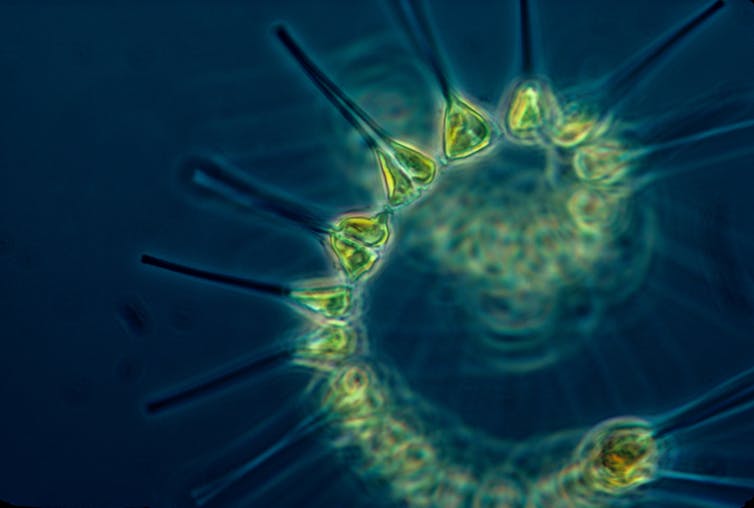
Getting to grips with marine geoengineering
Interest in marine geoengineering has grown over several decades as the climate crisis has worsened. Removing CO₂ from the atmosphere is now necessary to achieve “net-zero” emissions and limit global warming to 1.5℃. But marine geoengineering proposals also present risks to the marine environment.
The Southern Ocean – which extends from Australia’s southern coast to Antarctica – has been identified as a suitable location for ocean fertilisation. This involves feeding iron dust to marine algae. Through the process of photosynthesis, the algae pull CO₂ from the atmosphere, which is potentially stored in the deep ocean.
Another proposal is modifying acidity in oceans. Oceans naturally absorb large amounts of CO₂, which is making the water more acidic. Ocean acidification harms marine life, especially animals with shells. It also limits the amount of CO₂ that can be stored. A technology that essentially adds “antacids” to the ocean“ could help counteract this and enable the oceans to store more.
Other proposals seek to reduce the damage from marine heatwaves. "Marine cloud brightening” seeks to limit coral bleaching on the Great Barrier Reef, by spraying sea-salt particles into clouds. The idea is to make the clouds whiter, to better reflect sunlight away from the ocean and limit further warming of the water.
With help, the oceans could play an even bigger role in stabilising the climate. But there are concerns about unintended consequences of deliberately intervening. For example, ocean fertilisation could decrease water oxygen levels and “rob” neighbouring waters of nutrients, reducing marine productivity.
Marine geoengineering could also distract from efforts to cut emissions at source.
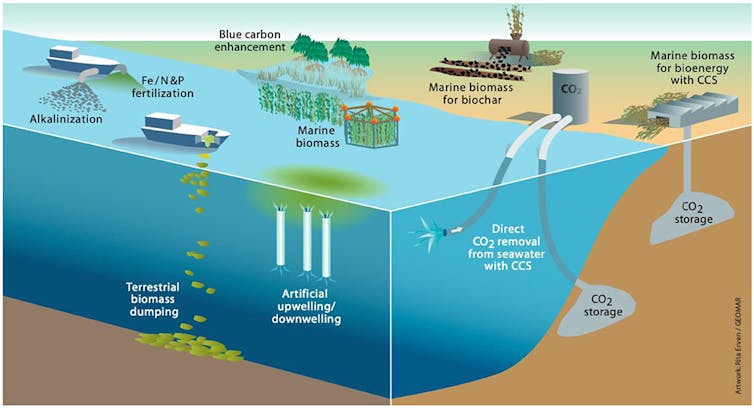
Strong rules to protect the marine environment
With this new bill, the Australian government has taken an important first step towards regulating marine geoengineering.
The bill involves proposed amendments to the Environment Protection (Sea Dumping) Act. It would introduce a permit system for legitimate scientific research activities.
Environment Minister Tanya Plibersek has said of the bill:
Regulating this type of activity, though a robust application, assessment and approval permitting process, would ensure that only legitimate scientific research activities exploring options to reduce atmospheric CO₂ can proceed. This amendment also provides for regulating other potentially harmful marine geoengineering research activities should they emerge in the future.
The bill implements Australia’s international obligations under the London Protocol, a marine pollution treaty that prohibits the dumping of waste at sea without a permit.
It follows a parliamentary inquiry that recommended Australia ratify these international rules. Australia’s support may encourage other countries to adopt these rules and make them legally binding.
Countries negotiated these rules in response to plans by private companies in the 2000s to conduct ocean fertilisation for profit. They decided new international rules were needed to protect the ocean. Currently, only ocean fertilisation is listed, and hence regulated, under these rules. But other activities may be listed in future.
The bill makes it an offence to place matter into the ocean for marine geoengineering without a permit. Permits may only be granted for scientific research activities. At present, these rules apply just to ocean fertilisation, as it is the only activity listed under the London Protocol.
If the bill is passed as it currently stands, commercial deployment of marine geoengineering cannot be conducted either in Australian waters or from Australian vessels.
Harsh criminal penalties will apply to people who conduct marine geoengineering without a permit. Offenders face 12 months imprisonment and/or a fine of up to $68,750.
The bill also establishes offences for loading and exporting material to be used for marine geoengineering without a permit.
Rules limit financial incentives for research
Prohibiting marine geoengineering deployment may be appropriate now. But without future prospects for deployment there may be little incentive to invest in research.
The treaty rules ban ocean-based research directly leading to financial and/or economic gain. This protection is important for building public trust and advancing the public interest. But broad prohibition could hamper marine geoengineering research for economic purposes such as eventual carbon crediting and trading. It could also call into question government subsidies and tax incentives encouraging private research investment.
The parliamentary inquiry did not consider the implications of the new rules for Australia’s carbon markets, or on research to save the Great Barrier Reef.
Changes could affect research to save the reef
Since 2019, the Australian government has invested in marine cloud brightening and other interventions to protect the reef from heat stress and coral bleaching. The first outdoor experiments were conducted in 2020.
The effectiveness of marine cloud brightening is yet to be demonstrated at scale. But modelling suggests a combination of marine cloud brightening and crown-of-thorns starfish control could help protect the reef until 2040.
The treaty rules do not currently apply to marine cloud brightening. However, countries are currently considering adding marine cloud brightening to the list of regulated activities. This could allow research but prohibit deployment. The government should evaluate how this could affect its investment in marine cloud brightening research and associated programs.
Australia’s marine environment is already suffering from warming and acidification. Appropriately-managed marine geoengineering activities may help reduce the damage and/or mitigate climate change.
The treaty’s environmental safeguards are important to ensure the risks from ocean fertilisation activities are rigorously evaluated.
The current bill favours risk management, which is appropriate at the early stages of research and development. But by ruling out future deployment, Australia may undermine incentives to advance research.
![]()
Kerryn Brent, Senior Lecturer, Adelaide Law School, University of Adelaide; Jan McDonald, Professor of Environmental Law, University of Tasmania, and Manon Simon, Research Fellow, University of Tasmania
11 July 2023
This article is republished from The Conversation under a Creative Commons license. Read the original article.
Keppel corals show resilience following severe bleaching

Corals in the Keppel Islands of the southern Great Barrier Reef survived and recovered from a severe bleaching event in 2020, indicating the high resilience of corals in the region, new research by the Australian Institute of Marine Science (AIMS) has found. The severe bleaching in Woppaburra sea Country, near Yeppoon, was part of the 2020 mass bleaching event of the Great Barrier Reef and affected 75%-98% of coral around the islands. But despite these corals being exposed to accumulated heat that often results in mortality, coral cover in the region was found to have remained stable, with very little mortality occurring.
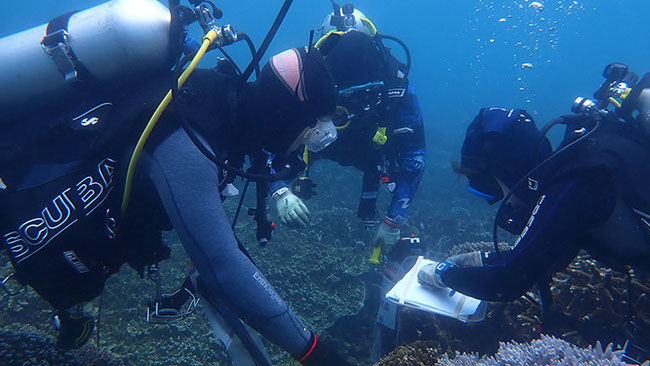
AIMS scientist Dr Cathie Page said the recovery following the bleaching event was driven by the easing of thermal stress in the region, possibly aided by environmental factors typical of the area like increased turbidity and large tidal flows. But she warned that the corals might not fare so well in future events under a warming climate because cooler recovery periods are diminishing, nullifying the benefits of high turbidity and water flow. “Reefs in this region are considered ‘highly disturbed’ and have been impacted by six major flooding events, four cyclones, four major storms and six coral bleaching events driven by marine heatwaves over the last 30 years,” said Dr Page. “They have been through a lot and we wanted to know more about what makes them so tough.

“Our research indicates strong recovery following the 2020 event.
“The Keppel region is characterised by a large tidal range and strong currents which can help to reduce water temperatures, provide sun protection and deliver extra food. Inshore corals are adept at feeding on the organic matter which is resuspended by these currents and that provide nutrition in the absence of the coral’s algal symbionts, which are lost in bleaching events.”
For the study, the team surveyed six reefs in different areas of the Keppel Island region in early April 2020 during the marine heatwave which caused severe bleaching. They surveyed these reefs, and an additional three sites, again in June and October 2020 to document the recovery of different species.
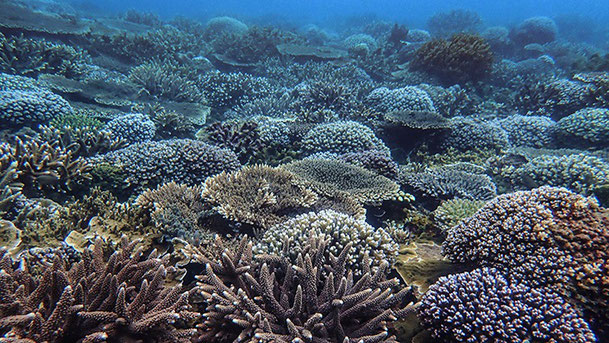
Dr Page said the Keppel reefs are dominated by fast-growing species in the Acropora family, which are highly susceptible to bleaching, but which they found mostly survived this event. “It may be that the frequent disturbances over 30 years have helped them adapt to a degree,” she added. “But it is unknown how long they and resilient corals in other regions can retain their ability to recover from bleaching events if they increase in frequency and intensity in a warming world.
“Frequent and severe bleaching events, such as the 2020 event we studied, highlight the importance of actions that slow and limit climate change. Dr Page added the knowledge gained from the Keppels study may allow scientists to identify reefs in different regions that might be particularly resilient to future bleaching events. They could serve as a natural source of coral larvae for the seeding of other reefs in a region. Coral seeding is a promising approach to help accelerate reef recovery on the Great Barrier Reef and around the world.
The research was published in the journal Ecosphere.
The research was carried out as part of the Woppaburra Coral Project, a component of the Australian Coral Reef Resilience Initiative, a research partnership between AIMS and BHP.
March 3 2023
'Source: Australian Institute of Marine Science' Creative Commons License icon

 Marine Science Australia
Marine Science Australia
